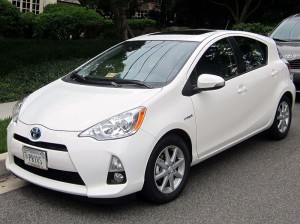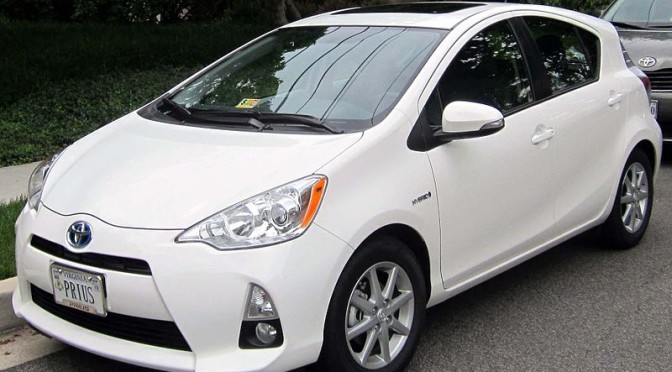The Toyota Prius C (the c stands for city) is one of the most fuel-efficient vehicles you can buy today in the United States, and is easily the most fuel-efficient non-electric car in the minicar segment, competing with other gas-sippers like the Honda Fit, Toyota Yaris, Ford Fiesta, Hyundai Accent, Kia Rio, and Chevrolet Sonic. Popular among the young and old alike, the Prius C may be a particular favorite of ecologically conscious parents who wish to leave their children a better world and promote a more sustainable future.
Ultimately, I fervently believe that the future isn’t in the giant vehicles that roam our streets and highways, but in much smaller vehicles like the C, and indeed, in far fewer personal vehicles (bicycles aside!) and in far better public infrastructure. But I’m getting ahead of myself. This guide is about 3 across compatibility, not sustainability!
I borrowed a Prius C this weekend to see how family-friendly it is when it comes to the all-important task of fitting multiple car seats into the back row. Before looking at which seats fared best, however, it’s worth taking a look at why it’s important to use certain seats at certain times with our children.
First of all, infants, toddlers, and preschoolers are safest when rear-facing. I recommend rear-facing as long as you can (ideally until 4!), before forward-facing them in harnessed convertible or combination seats (ideally until 8!). Once they outgrow their harnessed seats, I suggest keeping them in high-back boosters until they’re physically and psychologically ready to use adult seat belt systems (which typically happens between 10 and 12). What we want to do is keep our kids restrained in the safest positions for as long as possible to increase their odds of surviving crash forces.
Keeping these ideas in mind, I set to work to find which infant, convertible, combination, and booster seats would work best in 3 across combinations in the Toyota Prius C. I found several good options and a few great ones. If you find the list helpful when shopping for car seats, you can shop through my Amazon link below. I’ll add more seats as I test them over time.
You can access the complete 3 across guide for every vehicle here and the complete list of recommended seats here. The Canadian car seat guide is here. 3 across car seat images are courtesy of Wikipedia.
 2012, 2013, 2014, 2015, 2016, 2017 Toyota Prius C
2012, 2013, 2014, 2015, 2016, 2017 Toyota Prius C
Guaranteed 3 across installations:
Clek Fllo (x3).
Clek Foonf (x3).
Chicco KeyFit 30 (x3).
Clek Oobr (x3).
Diono Radian RXT (x3).
Diono Radian R120 (x3).
Diono Radian R100 (x3).
Combi Coccoro (x3).
Tips and Tricks:
The current generation of the Toyota Prius is barely 157 inches long and 67 inches wide, making it one of the narrowest vehicles I’ve ever tried to stuff 3 car seats into. However, it’s definitely possible if you use the seat belts (no way no how when it comes to LATCH) and take your time.
Out of the above convertibles, to be honest, I’d really just go with the Fllo or Foonf, as the Radians will take up a lot of front-to-back space that you really don’t have, while the Coccoro won’t be the best value for your money unless you have the specific needs to merit it over the Fllo / Foonf.
If you’re looking for an infant seat, go with the KeyFit 30. It’s light, narrow, and puzzles well with itself in small spaces.
If you insist on using one of the Radians, you’ll definitely need the angle adjuster, or you’re not going to have any front-passenger space to speak of.
—
If you find the information on car safety, recommended car seats, and car seat reviews on this car seat blog helpful, you can shop through this Amazon link for any purchases, car seat-related or not. Canadians can shop through this link for Canadian purchases.


